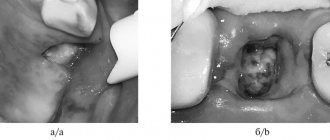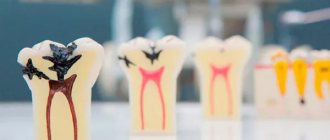Periodontitis is the development of an infectious-inflammatory process in the root membrane of the tooth and peri-root tissues, that is, in the periodontium. Periodontal tissues also include the gums and alveolar bone of the jaw. People of all ages can experience tooth root inflammation.
The main insidiousness of the disease is that in some forms it can be asymptomatic or with mild symptoms, and the localization of the inflammatory process makes its diagnosis difficult. However, failure to timely seek dental care in case of periodontitis can lead to a number of complications, including tooth loss.
Symptoms
Acute periodontitis is characterized by an attack of severe pain, during which swelling and swelling of the gums is observed, but the root top of the tooth is not yet destroyed. The chronic course of periodontitis practically does not manifest itself and is often asymptomatic; occasionally there is pain when biting. This stage of the disease can only be identified by contacting a dentist, who will make an accurate diagnosis using x-rays.
The acute form of the disease will not show any significant changes in the tooth area, but the chronic form will manifest itself in the appearance of a purulent sac, an abscess at the top of the root. In order not to cause damage to the oral cavity and save the tooth, long-term treatment will be required, which will take quite a lot of time, but it is also worth noting the fact that with modern medicine this process will be painless.
Treatment
When the pain can no longer be tolerated and medications do not help, you should immediately visit the dentist. When examining the patient, the doctor prescribes the necessary treatment, which will not be quick, but will lead to a complete recovery. The main goal of any dentist is to save the tooth.
During the initial examination, an x-ray is taken, with its help you can see the most complete picture of the disease. When the source of inflammation is found, you can begin to determine the form of the disease and treat the root. Today in dentistry, anesthesia is used not only for tooth extraction, as it was in Soviet times; modern drugs are mostly hypoallergenic, non-addictive, do not have a large list of contraindications, and can also be used in the treatment of children's teeth.
When treating a tooth root, the doctor ensures maximum comfort for the patient, anesthetizes the treatment site, then opens the tooth root and cleans it of purulent accumulation, then a special medicinal mixture is placed into the hole. Having covered the top with a special gasket, the doctor closes the tooth with a temporary filling.
Next, you need to wait a few days for the inflammation to subside. You need to wait about 5-7 days and take another picture to confirm that the inflammatory process has stopped. Next, the cleaned dental canals are re-filled and a new temporary filling is installed. Filling protects against new infections, which contribute to inflammation.
After three days, a final follow-up visit is made to the doctor, who, after examining the patient, making sure that there are no inflammatory processes and successful treatment, closes the tooth with a permanent filling and polishes it.
Subsequently, a restoration process occurs, during which the gums may still be sore, the tooth may even become loose, but after a while, the unpleasant symptoms will disappear. To avoid recurrent disease of the root of the treated tooth, the doctor’s appointment is repeated six months later.
How to relieve tooth inflammation
If inflammation of the root does not give you peace, then it is best not to delay a visit to the doctor. Traditional medicine at home is not intended to treat such a complex disease - we can say with confidence that self-medication will not bring the expected results. Relieving painful spasms and swelling with herbal infusions will only bring calm to the patient for a while, but the inflammatory process will develop and return after a while with more severe consequences.
The following will help to tame the pain for a while:
- Painkillers. They will help you endure acute pain, which is not advisable to endure, but it is best to drink them 12 hours before going to the doctor so that he can make a correct diagnosis;
- To relieve pain, you can rinse your mouth several times with a special solution, mixing a teaspoon of salt and soda in a glass of water, adding four drops of iodine;
- Using calendula tincture, you can relieve inflammation, mix a tablespoon of tincture with a glass of water, rinse your mouth up to 5 times;
- One of the modern recipes for relieving toothache: place two drops of propolis tincture on cotton wool and apply to the painful tooth, the pain should subside within an hour;
- Boil one teaspoon of chamomile and oak bark in a liter of water, leave for 20 minutes, cool slightly, rinse for inflammation;
It is important to remember that applying warm compresses to a sore spot is strictly prohibited! Rinsing and taking painkillers cannot be considered treatment, because even if you managed to relieve the pain, the inflammatory process has not been stopped, it will proceed unnoticed and will resume with renewed vigor, the consequences of which can be unpredictable.
Inflammation of a wisdom tooth
The location of this tooth in the oral cavity is sometimes difficult to reach for a doctor and is therefore considered the most difficult to treat. The wisdom tooth begins to erupt closer to the age of eighteen, which is why it received the name “comes with wisdom.” When it erupts, painful discomfort is felt, the reason is the absence of milk teeth in this place previously, so the incisor, growing, cuts through the gum. Swelling of the cheek and inflammation of the gums begins, which covers the area of the wisdom tooth; various symptoms may also appear, the lymph nodes become inflamed, swallowing becomes difficult, and the temperature rises.
A slight swelling can be considered normal, and the cause of the inflammatory process can be several factors:
- The wisdom tooth is looking for a place to come out, but not finding it creates inflammation in the gum and nerve;
- When the gums come out, there is not enough free space for normal growth, it begins to put pressure on the teeth in the neighborhood, which causes inflammation;
- The location of the growth of wisdom teeth depends on the structure of the oral cavity; if the shape is irregular, inflammation often occurs and cysts form.
To determine the presence of an inflammatory process in a wisdom tooth, you will need an x-ray; there are characteristic signs of inflammation:
- Sensation of unpleasant taste;
- Swelling of the gums around the tooth;
- The resulting pus spreads in the oral cavity, forming a pungent odor;
- When a wisdom tooth grows, the pain radiates to the temple or ear.
In this case, consulting a doctor is mandatory. If proper treatment is not started on time, it can lead to severe pain and many complications, the formation of purulent abscesses and phlegmons, which are subsequently resolved surgically.
Today, more and more dentists are of the opinion that the wisdom tooth does not need to be treated, but should simply be removed, because it's more trouble than it's worth. The complexity of treating its roots is determined by its location, and the doctor will make a decision in each individual case: to treat or remove a wisdom tooth.
Is it possible to cure pulpitis and how are nerves removed: types of anesthesia
As mentioned earlier, pulp inflammation is an extremely painful pathology, which primarily affects the nerve endings inside the oral cavity. The process of its treatment necessarily includes an operation to select a high-quality antiseptic that is suitable for a particular person. Moreover, the drug is applied to the desired places using various methods:
- application;
- infiltration;
- conductive;
- stem
The anesthetics used are traditional pairs of lidocaine and novocaine, as well as more advanced and modern formulations: Ultracaine, Ubistezin, Septanest, and so on.
Inflammation after tooth extraction - treatment
When there is no way to save a tooth, there is only one option left - to remove it. When removing, anesthesia is used, when its effect wears off, the tooth socket may ache, if the pain does not disappear within 2-3 days and painkillers do not help, most likely the inflammatory process of the tooth socket has begun. What could be causing it:
- Injury during tooth extraction;
- Foreign particles entering the hole cause inflammation;
- Improper hygiene;
- Infection in the hole.
To relieve inflammation after tooth extraction, you should not self-medicate; in this case, you should definitely consult a doctor.
Self-medication in this case can lead to the development of abscesses and sepsis. The doctor will correctly select the right antibiotic and dosage of the medicinal drug, an antiseptic solution for rinsing the mouth.
Causes of the disease
There are a number of reasons leading to tooth root inflammation:
- Deep caries. As you know, at the initial stage, caries is a stain that, without proper treatment, quickly deepens and covers an increasingly larger area of the tooth. Thus, caries passes through layers: enamel, then dentin, and later reaches the inner layer - the pulp. After this, pathological microorganisms can go down the root canal and cause an inflammatory process there. There is also a retrograde type of spread of infection - that is, the spread of pathogens occurs from the roots of the teeth.
- Poor quality dental care. Many people know that regardless of whether you want to remove tartar, put a filling, or just undergo a preventive examination, it is important to contact experienced dentists. Sometimes it happens that poor-quality dental care leads to periodontitis, for example, if the doctor unsuccessfully placed a filling/crown or chose the wrong treatment tactics for pulpitis (inflammation of the nerve of the tooth). There is drug-induced periodontitis, which is formed when chemicals, such as filling materials, enter the periodontal tissue. In the event of an allergic reaction, allergic periodontitis may occur.
- Injuries. Periodontitis often occurs as a result of injuries to the jaw or teeth. Sometimes the development of periodontitis is provoked by an accidental, strong bite of a hard object (for example, a fork).
- Serious inflammatory processes in the body. Sometimes inflammation of the tooth root occurs due to general intoxication of the body, when the infection spreads through the blood or lymph. Often periodontitis also occurs against the background of poisoning of the body.
Inflammation of the bone tissue of the tooth
The inflammatory process is the primary source of osteitis in the bone tissue of the jaw; if proper treatment is not provided in time, it will develop into periostitis (the periosteum becomes inflamed), osteomyelitis (the bone marrow becomes inflamed). With osteitis, pain is felt, the affected area swells, difficulties arise in chewing food, and the entire jaw gradually begins to ache. The cause of symptoms of osteitis is:
- Received traumatic actions, blows, bruises, jaw fracture;
- Surgical complication;
- tuberculosis and syphilis;
Treatment of osteitis occurs through surgery with the use of antibiotics and immunostimulating medications. Decaying teeth harbor bacteria and must be removed to prevent further inflammation. Patients with tuberculosis or syphilis first cure the underlying disease, then proceed to eliminate osteitis.
The slightest suspicion of pain in the bone tissue in the oral cavity is a reason to consult a doctor. Treatment of osteitis started in the first stage will make it possible to save teeth and protect against painful complications. Successful treatment depends on correct implementation of the dentist’s recommendations and careful oral care.
Preventive measures
Measures to prevent periodontitis are as follows:
- Regular and thorough oral hygiene using fluoridated toothpastes.
- Treat bacterial plaque (especially after eating) using dental floss, brushes, etc.
- A scheduled visit to the dentist (once every six months), who will promptly treat caries, remove tartar, and more.
- A healthy diet containing vitamins, complex carbohydrates, and beneficial microelements. All this is found in fresh vegetables and fruits, dairy products, protein-rich foods, etc.
- Minimize the consumption of preservatives and various artificial flavor enhancers, sugar-containing foods and drinks (especially soda).
And most importantly, do not start dental disease at the slightest manifestation. Untreated and extremely advanced forms of caries and pulpitis are the main cause of periodontitis.











